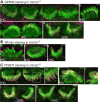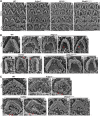Individual USH2 proteins make distinct contributions to the ankle link complex during development of the mouse cochlear stereociliary bundle
- PMID: 26401052
- PMCID: PMC4654051
- DOI: 10.1093/hmg/ddv398
Individual USH2 proteins make distinct contributions to the ankle link complex during development of the mouse cochlear stereociliary bundle
Abstract
Usher syndrome (USH) is the leading cause of inherited deaf-blindness, with type 2 (USH2) being the most common clinical form. Studies suggest that proteins encoded by USH2 causative genes assemble into the ankle link complex (ALC) at the hair cell stereociliary bundle; however, little is known about the in vivo assembly and function of this complex. Using various USH2 mutant mice, we showed by immunofluorescence that USH2 proteins play different roles in cochlear ALC assembly, with G protein-coupled receptor 98 being the most important protein. Complex assembly likely occurs at the stereociliary bundle but not along the protein transport route in the cell body. Stereociliary morphological defects in USH2 mutant mice suggest roles for the ALC in regulating inner hair cell stereociliary growth and differentiation as well as outer hair cell stereociliary rigidity and organization during development. These roles are unique from the bundle cohesion role of Usher syndrome type 1 protein complexes. Loss of individual USH2 gene expressions leads to variable morphological and functional consequences, correlating with the severity of ALC disruption. This finding suggests a potential genotype-phenotype correlation in USH2 patients. In summary, this study provides novel insights into the molecular mechanism underlying cochlear stereociliary bundle development and hearing loss pathogenesis of various USH2 subtypes. Our thorough phenotypical characterization of USH2 mouse models is essential for future use of these animal models in therapeutic development.
© The Author 2015. Published by Oxford University Press. All rights reserved. For Permissions, please email: journals.permissions@oup.com.
Figures











References
-
- Assad J.A., Shepherd G.M., Corey D.P. (1991) Tip-link integrity and mechanical transduction in vertebrate hair cells. Neuron, 7, 985–994. - PubMed
-
- Hudspeth A.J. (1985) Models for mechanoelectrical transduction by hair cells. Prog. Clin. Biol. Res., 176, 193–205. - PubMed
-
- Frolenkov G.I., Belyantseva I.A., Friedman T.B., Griffith A.J. (2004) Genetic insights into the morphogenesis of inner ear hair cells. Nat. Rev. Genet., 5, 489–498. - PubMed
-
- Nayak G.D., Ratnayaka H.S., Goodyear R.J., Richardson G.P. (2007) Development of the hair bundle and mechanotransduction. Int. J. Dev. Biol., 51, 597–608. - PubMed
Publication types
MeSH terms
Substances
Grants and funding
LinkOut - more resources
Full Text Sources
Other Literature Sources
Medical
Molecular Biology Databases

